Delivering Change: A Comparative Study of Tesco and Sainsbury
VerifiedAdded on 2024/06/28
|32
|5317
|439
Report
AI Summary
This report provides a comprehensive analysis of change management strategies implemented by Tesco and Sainsbury, two major supermarket chains. It begins with an introduction to both companies, highlighting the changes they have undergone in response to internal and external factors. The report explores the forces and drivers of change, such as competition, customer preferences, economic needs, environmental concerns, market demand, social benefits, and regulations. It then analyzes the impact of these drivers using SWOT and PESTLE analyses for both Tesco and Sainsbury. Various change management models, including the Burke Litwin Change Model, ADKAR Model, Kotter’s Model, and Lewin's Change Model, are discussed as tools to mitigate negative impacts and facilitate change. The report also examines barriers to change and their effects on managerial decisions, using force field analysis to illustrate the driving and restraining forces. Finally, it explores different leadership approaches in change management and evaluates the extent to which models and leadership approaches contribute to delivering successful change within these organizations. Desklib offers this and many more solved assignments for students.
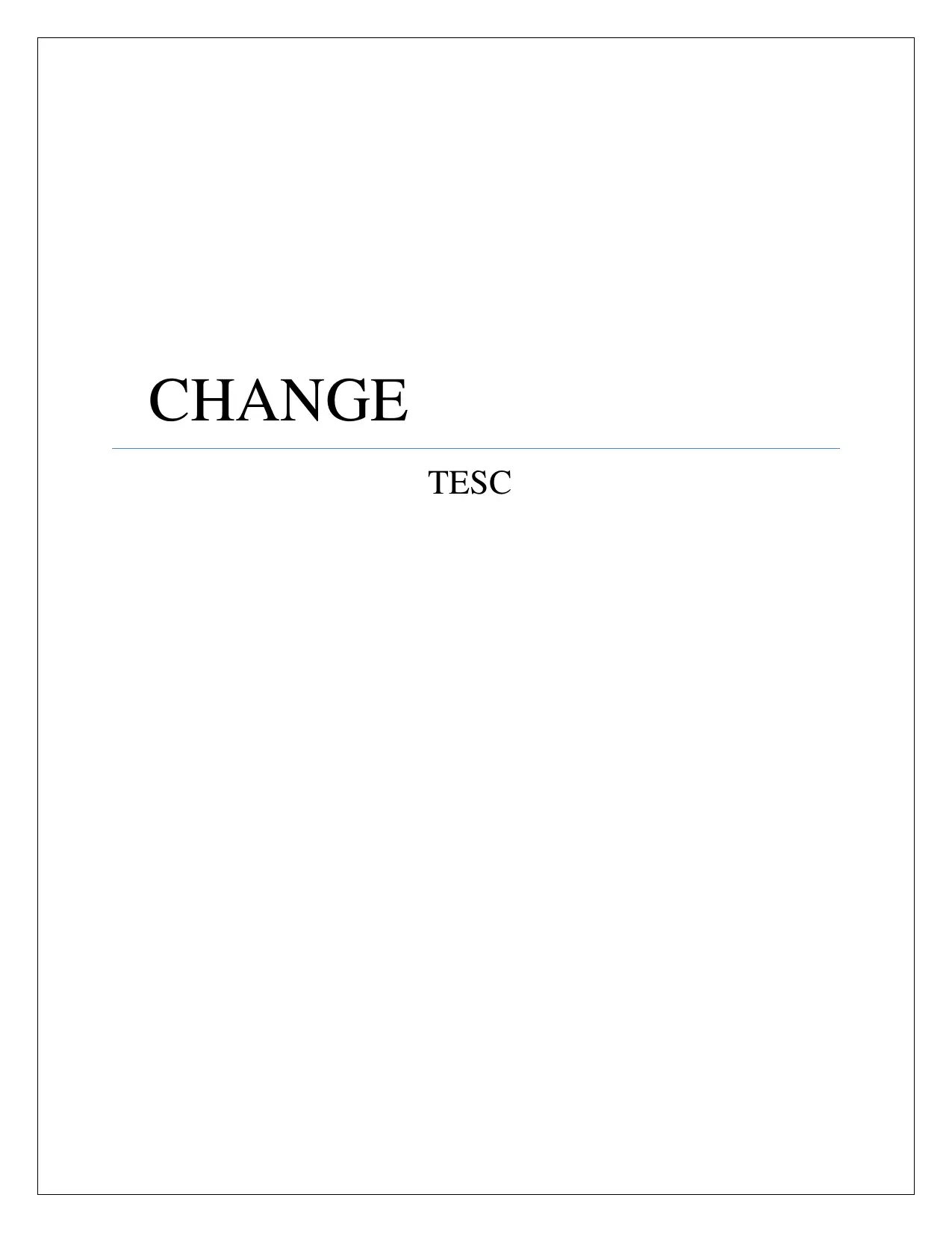
Paraphrase This Document
Need a fresh take? Get an instant paraphrase of this document with our AI Paraphraser
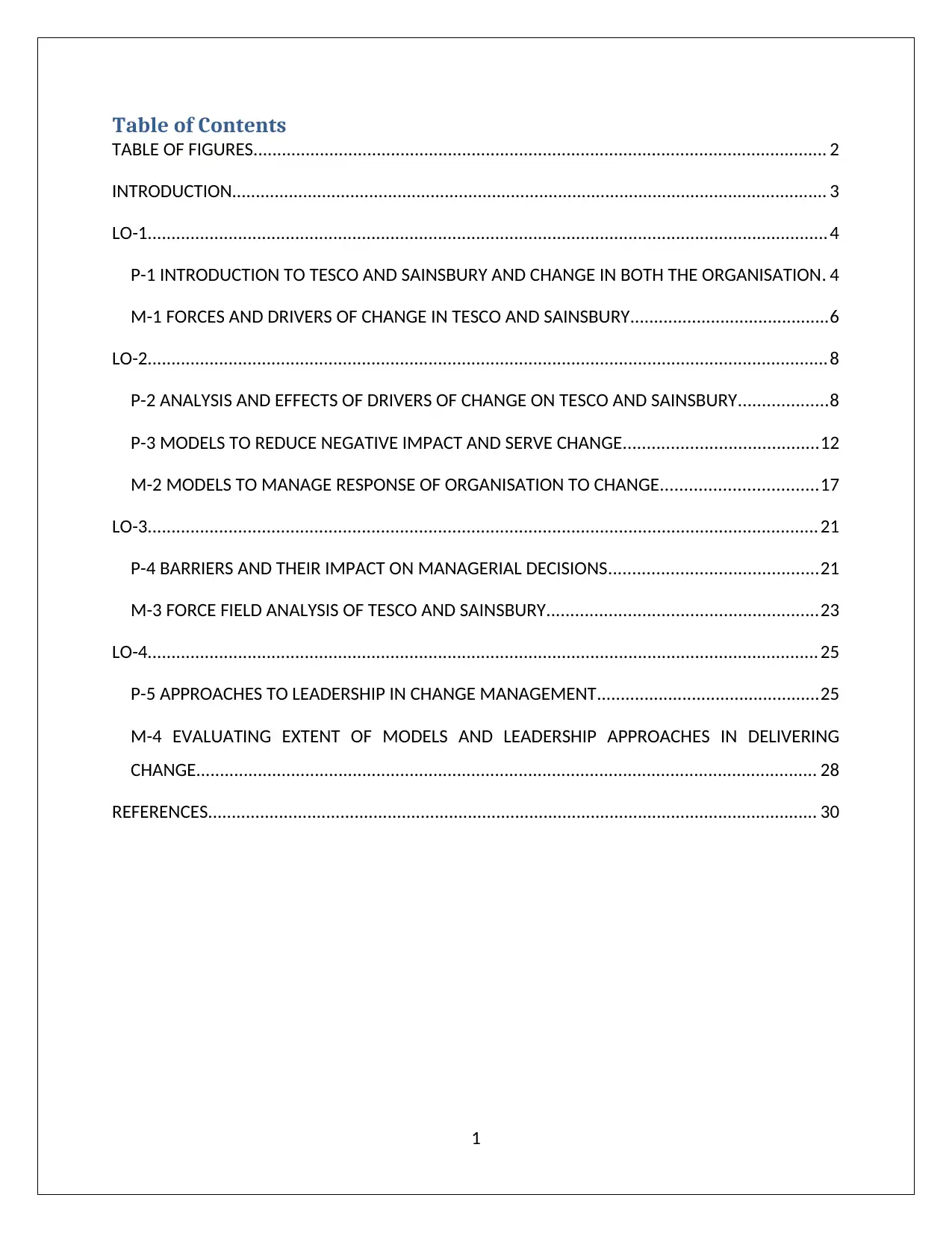
Table of Contents
TABLE OF FIGURES......................................................................................................................... 2
INTRODUCTION.............................................................................................................................. 3
LO-1...............................................................................................................................................4
P-1 INTRODUCTION TO TESCO AND SAINSBURY AND CHANGE IN BOTH THE ORGANISATION. 4
M-1 FORCES AND DRIVERS OF CHANGE IN TESCO AND SAINSBURY..........................................6
LO-2...............................................................................................................................................8
P-2 ANALYSIS AND EFFECTS OF DRIVERS OF CHANGE ON TESCO AND SAINSBURY...................8
P-3 MODELS TO REDUCE NEGATIVE IMPACT AND SERVE CHANGE.........................................12
M-2 MODELS TO MANAGE RESPONSE OF ORGANISATION TO CHANGE.................................17
LO-3............................................................................................................................................. 21
P-4 BARRIERS AND THEIR IMPACT ON MANAGERIAL DECISIONS............................................21
M-3 FORCE FIELD ANALYSIS OF TESCO AND SAINSBURY.........................................................23
LO-4............................................................................................................................................. 25
P-5 APPROACHES TO LEADERSHIP IN CHANGE MANAGEMENT...............................................25
M-4 EVALUATING EXTENT OF MODELS AND LEADERSHIP APPROACHES IN DELIVERING
CHANGE................................................................................................................................... 28
REFERENCES................................................................................................................................. 30
1
TABLE OF FIGURES......................................................................................................................... 2
INTRODUCTION.............................................................................................................................. 3
LO-1...............................................................................................................................................4
P-1 INTRODUCTION TO TESCO AND SAINSBURY AND CHANGE IN BOTH THE ORGANISATION. 4
M-1 FORCES AND DRIVERS OF CHANGE IN TESCO AND SAINSBURY..........................................6
LO-2...............................................................................................................................................8
P-2 ANALYSIS AND EFFECTS OF DRIVERS OF CHANGE ON TESCO AND SAINSBURY...................8
P-3 MODELS TO REDUCE NEGATIVE IMPACT AND SERVE CHANGE.........................................12
M-2 MODELS TO MANAGE RESPONSE OF ORGANISATION TO CHANGE.................................17
LO-3............................................................................................................................................. 21
P-4 BARRIERS AND THEIR IMPACT ON MANAGERIAL DECISIONS............................................21
M-3 FORCE FIELD ANALYSIS OF TESCO AND SAINSBURY.........................................................23
LO-4............................................................................................................................................. 25
P-5 APPROACHES TO LEADERSHIP IN CHANGE MANAGEMENT...............................................25
M-4 EVALUATING EXTENT OF MODELS AND LEADERSHIP APPROACHES IN DELIVERING
CHANGE................................................................................................................................... 28
REFERENCES................................................................................................................................. 30
1
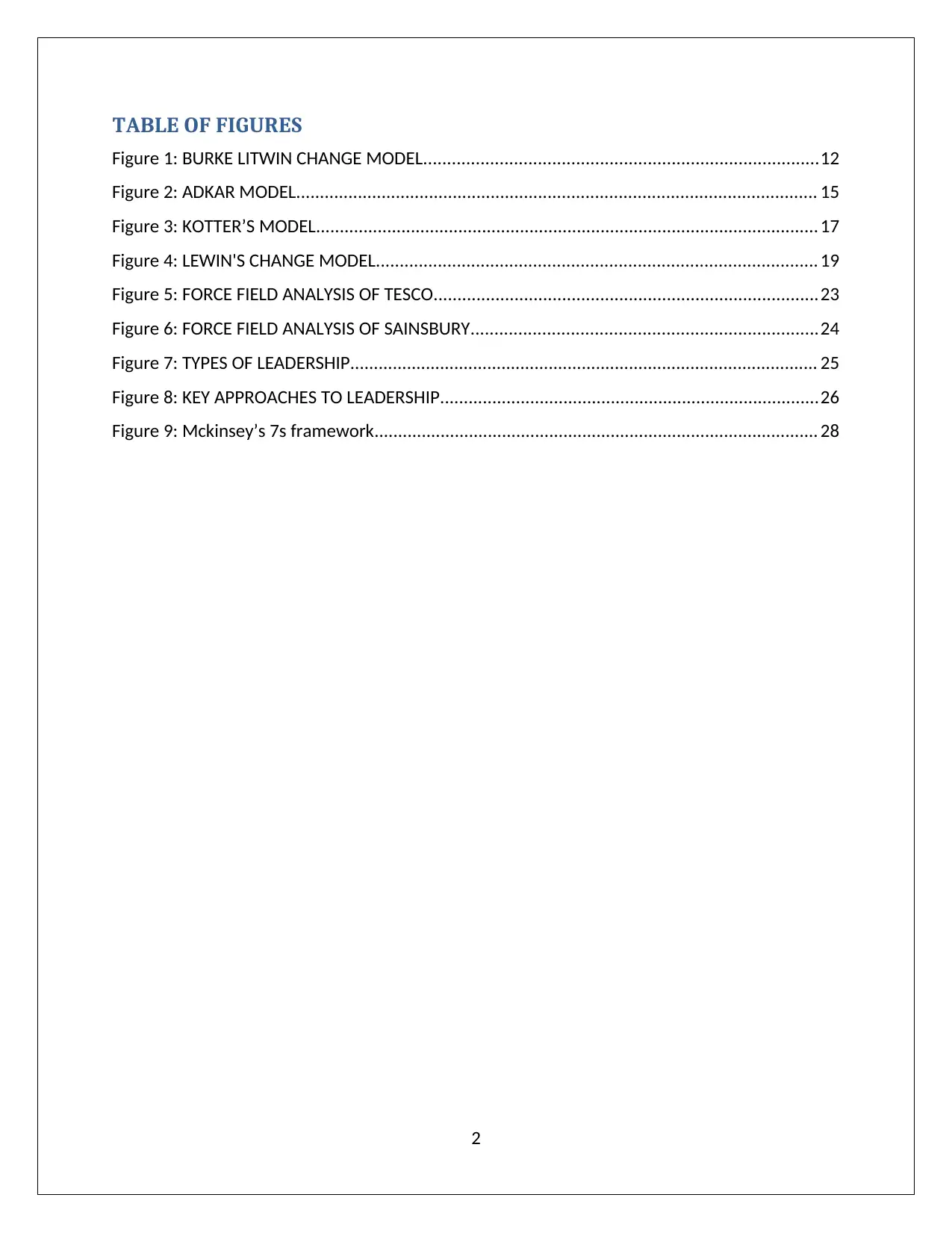
TABLE OF FIGURES
Figure 1: BURKE LITWIN CHANGE MODEL...................................................................................12
Figure 2: ADKAR MODEL.............................................................................................................. 15
Figure 3: KOTTER’S MODEL.......................................................................................................... 17
Figure 4: LEWIN'S CHANGE MODEL............................................................................................. 19
Figure 5: FORCE FIELD ANALYSIS OF TESCO.................................................................................23
Figure 6: FORCE FIELD ANALYSIS OF SAINSBURY.........................................................................24
Figure 7: TYPES OF LEADERSHIP................................................................................................... 25
Figure 8: KEY APPROACHES TO LEADERSHIP................................................................................26
Figure 9: Mckinsey’s 7s framework.............................................................................................. 28
2
Figure 1: BURKE LITWIN CHANGE MODEL...................................................................................12
Figure 2: ADKAR MODEL.............................................................................................................. 15
Figure 3: KOTTER’S MODEL.......................................................................................................... 17
Figure 4: LEWIN'S CHANGE MODEL............................................................................................. 19
Figure 5: FORCE FIELD ANALYSIS OF TESCO.................................................................................23
Figure 6: FORCE FIELD ANALYSIS OF SAINSBURY.........................................................................24
Figure 7: TYPES OF LEADERSHIP................................................................................................... 25
Figure 8: KEY APPROACHES TO LEADERSHIP................................................................................26
Figure 9: Mckinsey’s 7s framework.............................................................................................. 28
2
⊘ This is a preview!⊘
Do you want full access?
Subscribe today to unlock all pages.

Trusted by 1+ million students worldwide
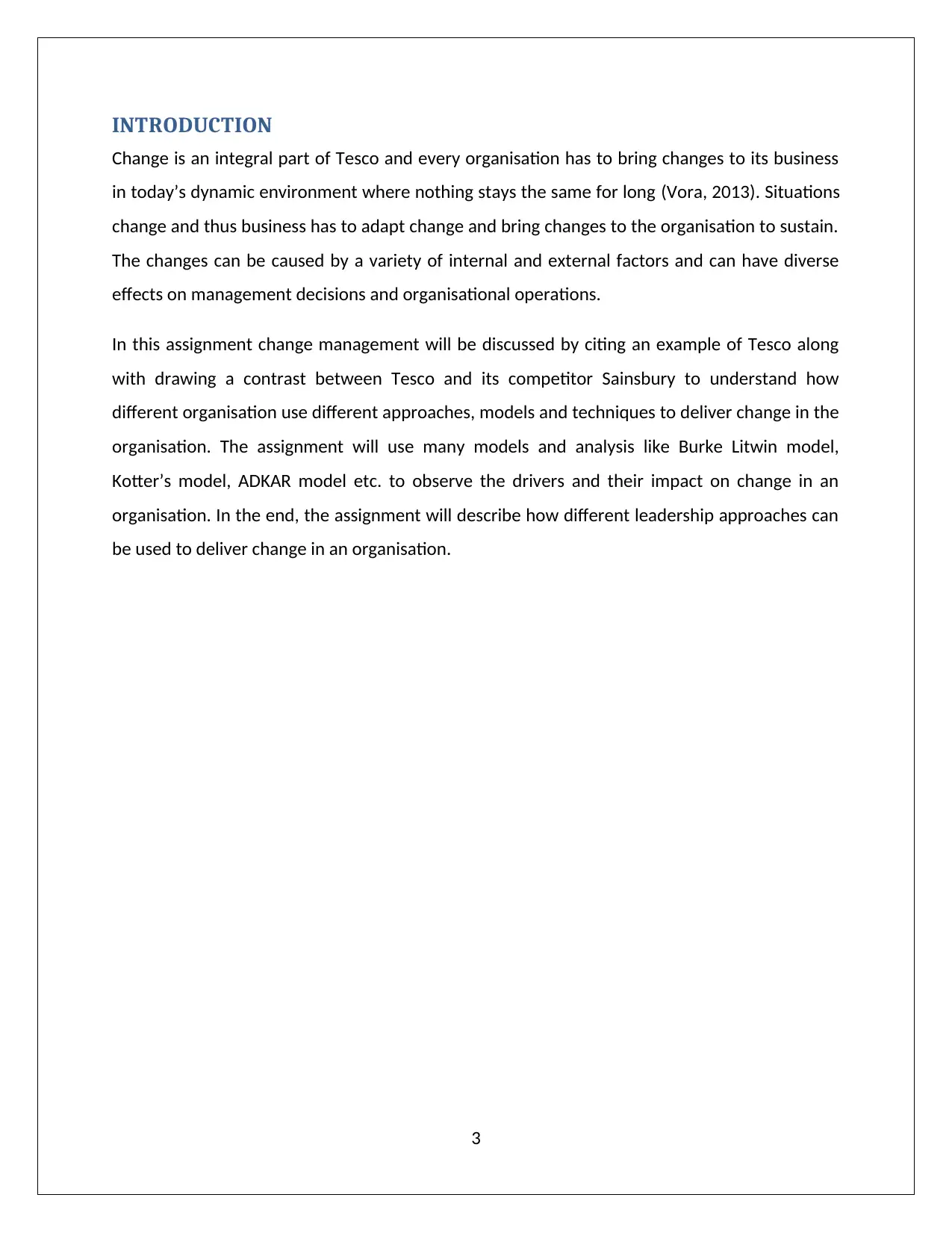
INTRODUCTION
Change is an integral part of Tesco and every organisation has to bring changes to its business
in today’s dynamic environment where nothing stays the same for long (Vora, 2013). Situations
change and thus business has to adapt change and bring changes to the organisation to sustain.
The changes can be caused by a variety of internal and external factors and can have diverse
effects on management decisions and organisational operations.
In this assignment change management will be discussed by citing an example of Tesco along
with drawing a contrast between Tesco and its competitor Sainsbury to understand how
different organisation use different approaches, models and techniques to deliver change in the
organisation. The assignment will use many models and analysis like Burke Litwin model,
Kotter’s model, ADKAR model etc. to observe the drivers and their impact on change in an
organisation. In the end, the assignment will describe how different leadership approaches can
be used to deliver change in an organisation.
3
Change is an integral part of Tesco and every organisation has to bring changes to its business
in today’s dynamic environment where nothing stays the same for long (Vora, 2013). Situations
change and thus business has to adapt change and bring changes to the organisation to sustain.
The changes can be caused by a variety of internal and external factors and can have diverse
effects on management decisions and organisational operations.
In this assignment change management will be discussed by citing an example of Tesco along
with drawing a contrast between Tesco and its competitor Sainsbury to understand how
different organisation use different approaches, models and techniques to deliver change in the
organisation. The assignment will use many models and analysis like Burke Litwin model,
Kotter’s model, ADKAR model etc. to observe the drivers and their impact on change in an
organisation. In the end, the assignment will describe how different leadership approaches can
be used to deliver change in an organisation.
3
Paraphrase This Document
Need a fresh take? Get an instant paraphrase of this document with our AI Paraphraser
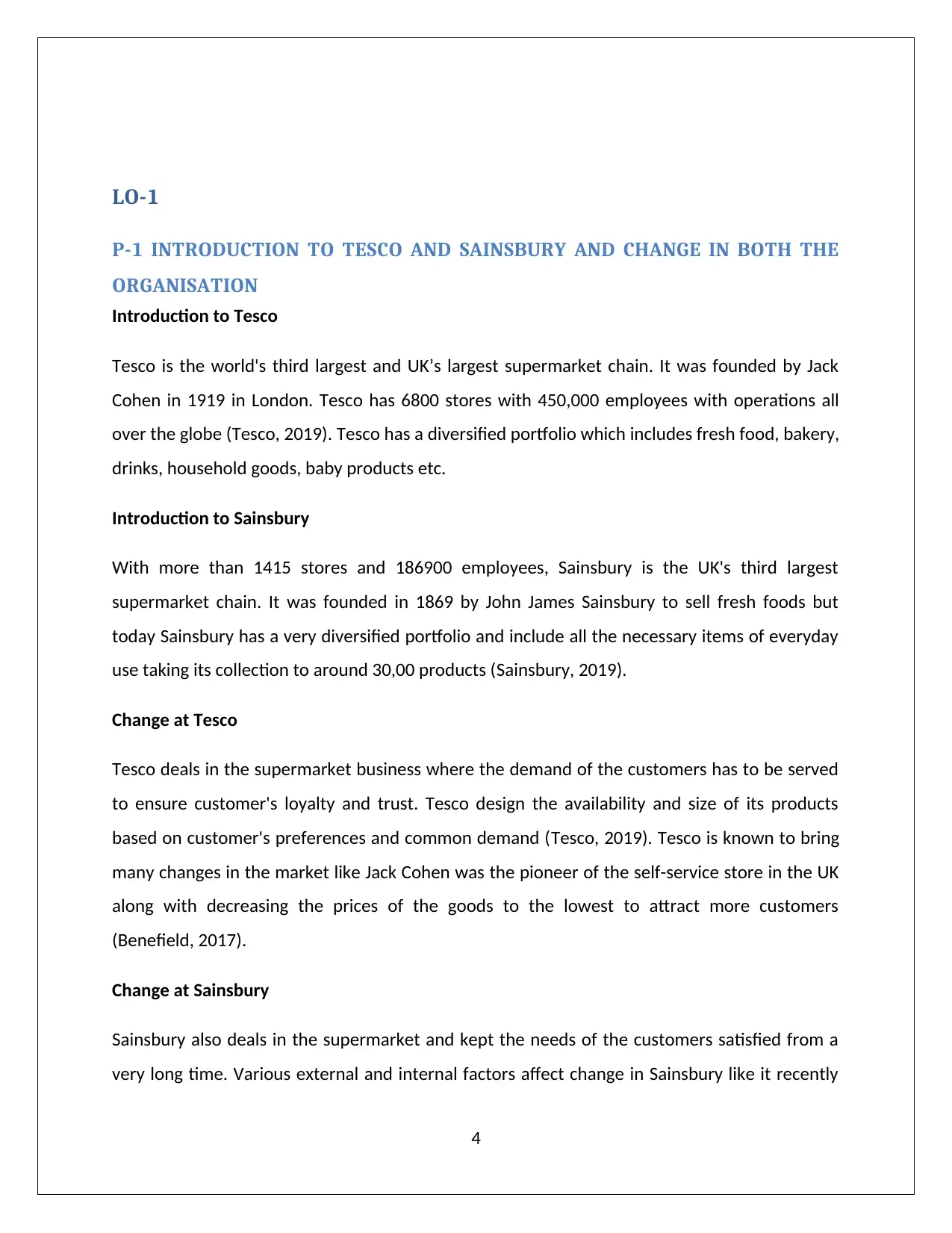
LO-1
P-1 INTRODUCTION TO TESCO AND SAINSBURY AND CHANGE IN BOTH THE
ORGANISATION
Introduction to Tesco
Tesco is the world's third largest and UK’s largest supermarket chain. It was founded by Jack
Cohen in 1919 in London. Tesco has 6800 stores with 450,000 employees with operations all
over the globe (Tesco, 2019). Tesco has a diversified portfolio which includes fresh food, bakery,
drinks, household goods, baby products etc.
Introduction to Sainsbury
With more than 1415 stores and 186900 employees, Sainsbury is the UK's third largest
supermarket chain. It was founded in 1869 by John James Sainsbury to sell fresh foods but
today Sainsbury has a very diversified portfolio and include all the necessary items of everyday
use taking its collection to around 30,00 products (Sainsbury, 2019).
Change at Tesco
Tesco deals in the supermarket business where the demand of the customers has to be served
to ensure customer's loyalty and trust. Tesco design the availability and size of its products
based on customer's preferences and common demand (Tesco, 2019). Tesco is known to bring
many changes in the market like Jack Cohen was the pioneer of the self-service store in the UK
along with decreasing the prices of the goods to the lowest to attract more customers
(Benefield, 2017).
Change at Sainsbury
Sainsbury also deals in the supermarket and kept the needs of the customers satisfied from a
very long time. Various external and internal factors affect change in Sainsbury like it recently
4
P-1 INTRODUCTION TO TESCO AND SAINSBURY AND CHANGE IN BOTH THE
ORGANISATION
Introduction to Tesco
Tesco is the world's third largest and UK’s largest supermarket chain. It was founded by Jack
Cohen in 1919 in London. Tesco has 6800 stores with 450,000 employees with operations all
over the globe (Tesco, 2019). Tesco has a diversified portfolio which includes fresh food, bakery,
drinks, household goods, baby products etc.
Introduction to Sainsbury
With more than 1415 stores and 186900 employees, Sainsbury is the UK's third largest
supermarket chain. It was founded in 1869 by John James Sainsbury to sell fresh foods but
today Sainsbury has a very diversified portfolio and include all the necessary items of everyday
use taking its collection to around 30,00 products (Sainsbury, 2019).
Change at Tesco
Tesco deals in the supermarket business where the demand of the customers has to be served
to ensure customer's loyalty and trust. Tesco design the availability and size of its products
based on customer's preferences and common demand (Tesco, 2019). Tesco is known to bring
many changes in the market like Jack Cohen was the pioneer of the self-service store in the UK
along with decreasing the prices of the goods to the lowest to attract more customers
(Benefield, 2017).
Change at Sainsbury
Sainsbury also deals in the supermarket and kept the needs of the customers satisfied from a
very long time. Various external and internal factors affect change in Sainsbury like it recently
4
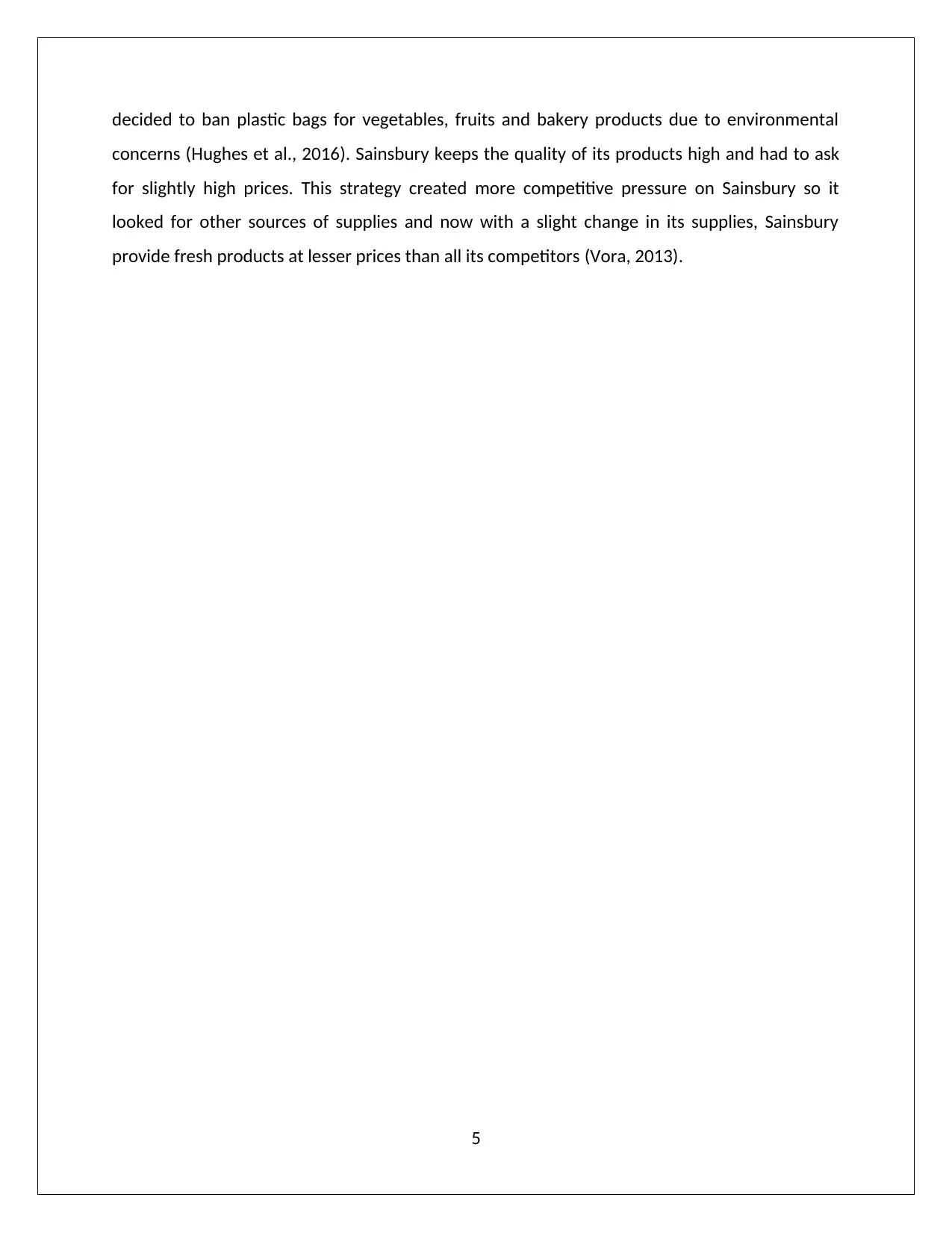
decided to ban plastic bags for vegetables, fruits and bakery products due to environmental
concerns (Hughes et al., 2016). Sainsbury keeps the quality of its products high and had to ask
for slightly high prices. This strategy created more competitive pressure on Sainsbury so it
looked for other sources of supplies and now with a slight change in its supplies, Sainsbury
provide fresh products at lesser prices than all its competitors (Vora, 2013).
5
concerns (Hughes et al., 2016). Sainsbury keeps the quality of its products high and had to ask
for slightly high prices. This strategy created more competitive pressure on Sainsbury so it
looked for other sources of supplies and now with a slight change in its supplies, Sainsbury
provide fresh products at lesser prices than all its competitors (Vora, 2013).
5
⊘ This is a preview!⊘
Do you want full access?
Subscribe today to unlock all pages.

Trusted by 1+ million students worldwide
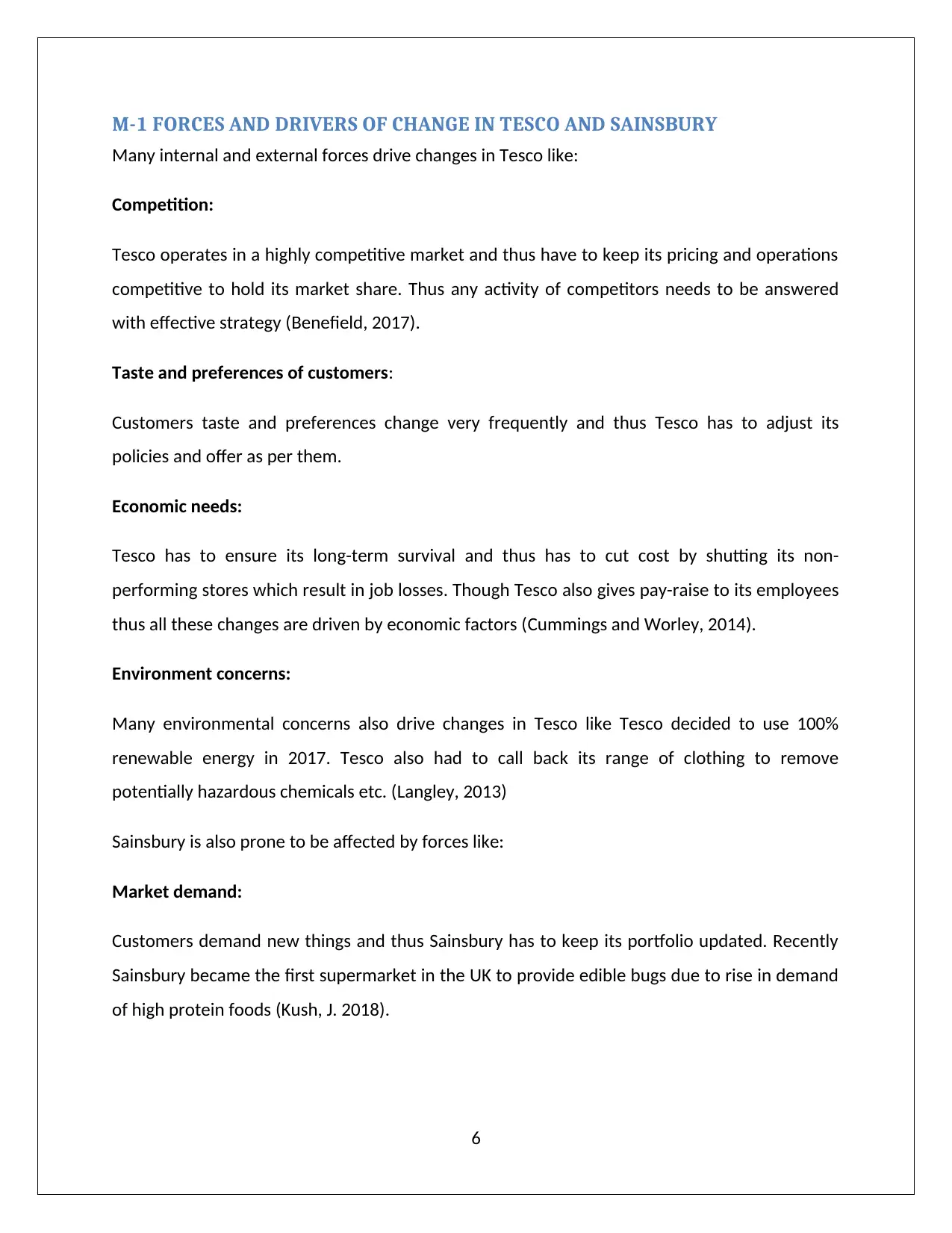
M-1 FORCES AND DRIVERS OF CHANGE IN TESCO AND SAINSBURY
Many internal and external forces drive changes in Tesco like:
Competition:
Tesco operates in a highly competitive market and thus have to keep its pricing and operations
competitive to hold its market share. Thus any activity of competitors needs to be answered
with effective strategy (Benefield, 2017).
Taste and preferences of customers:
Customers taste and preferences change very frequently and thus Tesco has to adjust its
policies and offer as per them.
Economic needs:
Tesco has to ensure its long-term survival and thus has to cut cost by shutting its non-
performing stores which result in job losses. Though Tesco also gives pay-raise to its employees
thus all these changes are driven by economic factors (Cummings and Worley, 2014).
Environment concerns:
Many environmental concerns also drive changes in Tesco like Tesco decided to use 100%
renewable energy in 2017. Tesco also had to call back its range of clothing to remove
potentially hazardous chemicals etc. (Langley, 2013)
Sainsbury is also prone to be affected by forces like:
Market demand:
Customers demand new things and thus Sainsbury has to keep its portfolio updated. Recently
Sainsbury became the first supermarket in the UK to provide edible bugs due to rise in demand
of high protein foods (Kush, J. 2018).
6
Many internal and external forces drive changes in Tesco like:
Competition:
Tesco operates in a highly competitive market and thus have to keep its pricing and operations
competitive to hold its market share. Thus any activity of competitors needs to be answered
with effective strategy (Benefield, 2017).
Taste and preferences of customers:
Customers taste and preferences change very frequently and thus Tesco has to adjust its
policies and offer as per them.
Economic needs:
Tesco has to ensure its long-term survival and thus has to cut cost by shutting its non-
performing stores which result in job losses. Though Tesco also gives pay-raise to its employees
thus all these changes are driven by economic factors (Cummings and Worley, 2014).
Environment concerns:
Many environmental concerns also drive changes in Tesco like Tesco decided to use 100%
renewable energy in 2017. Tesco also had to call back its range of clothing to remove
potentially hazardous chemicals etc. (Langley, 2013)
Sainsbury is also prone to be affected by forces like:
Market demand:
Customers demand new things and thus Sainsbury has to keep its portfolio updated. Recently
Sainsbury became the first supermarket in the UK to provide edible bugs due to rise in demand
of high protein foods (Kush, J. 2018).
6
Paraphrase This Document
Need a fresh take? Get an instant paraphrase of this document with our AI Paraphraser
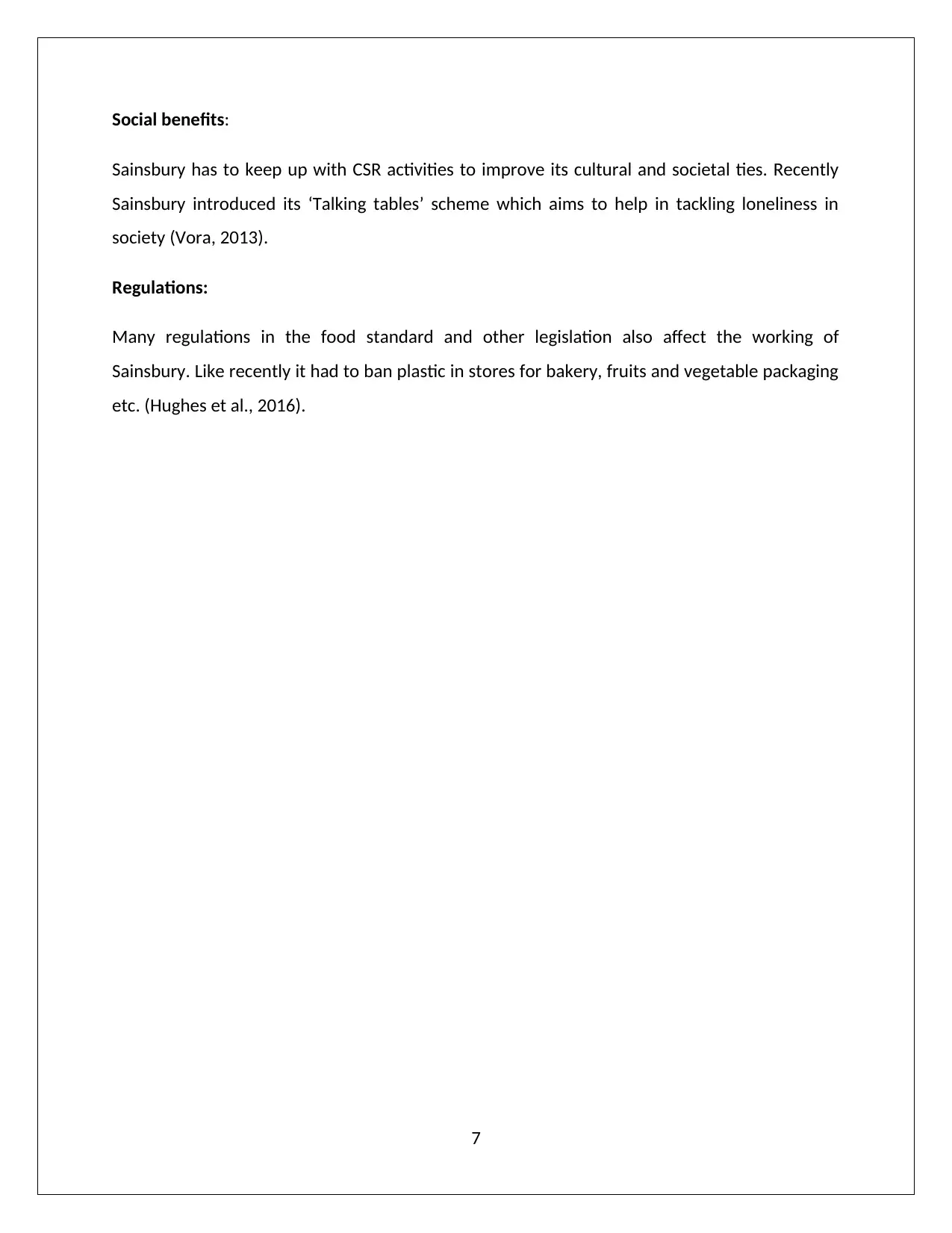
Social benefits:
Sainsbury has to keep up with CSR activities to improve its cultural and societal ties. Recently
Sainsbury introduced its ‘Talking tables’ scheme which aims to help in tackling loneliness in
society (Vora, 2013).
Regulations:
Many regulations in the food standard and other legislation also affect the working of
Sainsbury. Like recently it had to ban plastic in stores for bakery, fruits and vegetable packaging
etc. (Hughes et al., 2016).
7
Sainsbury has to keep up with CSR activities to improve its cultural and societal ties. Recently
Sainsbury introduced its ‘Talking tables’ scheme which aims to help in tackling loneliness in
society (Vora, 2013).
Regulations:
Many regulations in the food standard and other legislation also affect the working of
Sainsbury. Like recently it had to ban plastic in stores for bakery, fruits and vegetable packaging
etc. (Hughes et al., 2016).
7
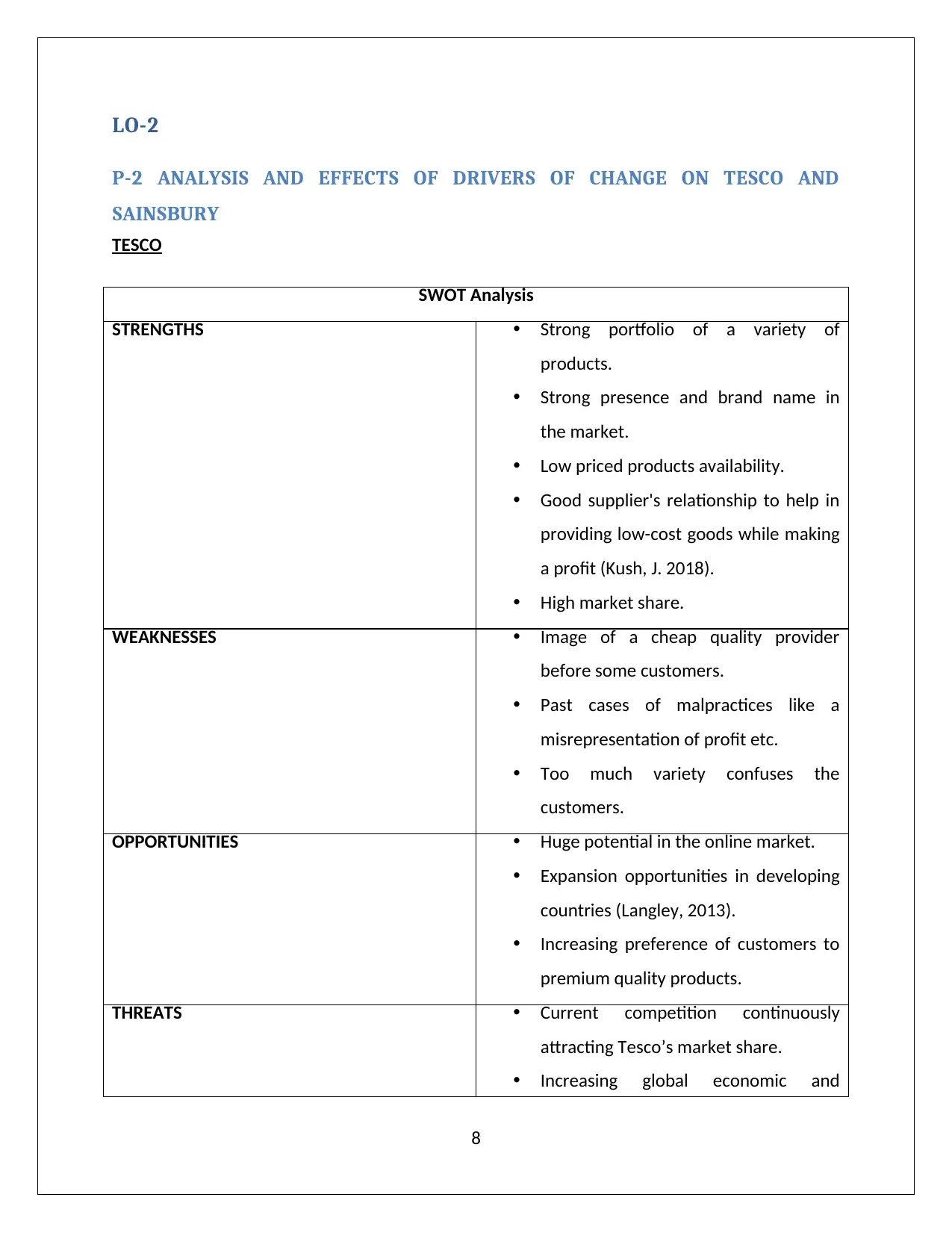
LO-2
P-2 ANALYSIS AND EFFECTS OF DRIVERS OF CHANGE ON TESCO AND
SAINSBURY
TESCO
SWOT Analysis
STRENGTHS Strong portfolio of a variety of
products.
Strong presence and brand name in
the market.
Low priced products availability.
Good supplier's relationship to help in
providing low-cost goods while making
a profit (Kush, J. 2018).
High market share.
WEAKNESSES Image of a cheap quality provider
before some customers.
Past cases of malpractices like a
misrepresentation of profit etc.
Too much variety confuses the
customers.
OPPORTUNITIES Huge potential in the online market.
Expansion opportunities in developing
countries (Langley, 2013).
Increasing preference of customers to
premium quality products.
THREATS Current competition continuously
attracting Tesco’s market share.
Increasing global economic and
8
P-2 ANALYSIS AND EFFECTS OF DRIVERS OF CHANGE ON TESCO AND
SAINSBURY
TESCO
SWOT Analysis
STRENGTHS Strong portfolio of a variety of
products.
Strong presence and brand name in
the market.
Low priced products availability.
Good supplier's relationship to help in
providing low-cost goods while making
a profit (Kush, J. 2018).
High market share.
WEAKNESSES Image of a cheap quality provider
before some customers.
Past cases of malpractices like a
misrepresentation of profit etc.
Too much variety confuses the
customers.
OPPORTUNITIES Huge potential in the online market.
Expansion opportunities in developing
countries (Langley, 2013).
Increasing preference of customers to
premium quality products.
THREATS Current competition continuously
attracting Tesco’s market share.
Increasing global economic and
8
⊘ This is a preview!⊘
Do you want full access?
Subscribe today to unlock all pages.

Trusted by 1+ million students worldwide
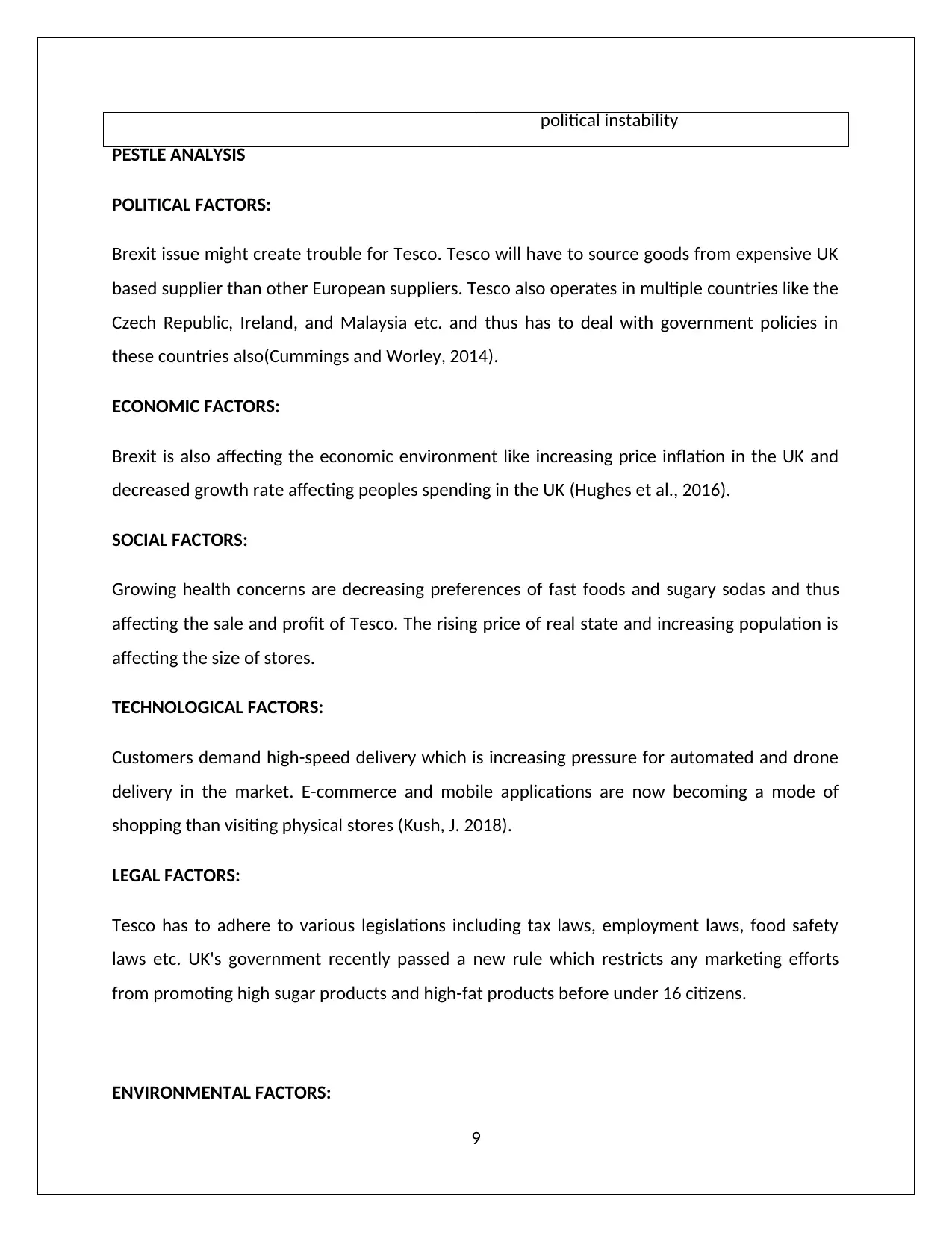
political instability
PESTLE ANALYSIS
POLITICAL FACTORS:
Brexit issue might create trouble for Tesco. Tesco will have to source goods from expensive UK
based supplier than other European suppliers. Tesco also operates in multiple countries like the
Czech Republic, Ireland, and Malaysia etc. and thus has to deal with government policies in
these countries also(Cummings and Worley, 2014).
ECONOMIC FACTORS:
Brexit is also affecting the economic environment like increasing price inflation in the UK and
decreased growth rate affecting peoples spending in the UK (Hughes et al., 2016).
SOCIAL FACTORS:
Growing health concerns are decreasing preferences of fast foods and sugary sodas and thus
affecting the sale and profit of Tesco. The rising price of real state and increasing population is
affecting the size of stores.
TECHNOLOGICAL FACTORS:
Customers demand high-speed delivery which is increasing pressure for automated and drone
delivery in the market. E-commerce and mobile applications are now becoming a mode of
shopping than visiting physical stores (Kush, J. 2018).
LEGAL FACTORS:
Tesco has to adhere to various legislations including tax laws, employment laws, food safety
laws etc. UK's government recently passed a new rule which restricts any marketing efforts
from promoting high sugar products and high-fat products before under 16 citizens.
ENVIRONMENTAL FACTORS:
9
PESTLE ANALYSIS
POLITICAL FACTORS:
Brexit issue might create trouble for Tesco. Tesco will have to source goods from expensive UK
based supplier than other European suppliers. Tesco also operates in multiple countries like the
Czech Republic, Ireland, and Malaysia etc. and thus has to deal with government policies in
these countries also(Cummings and Worley, 2014).
ECONOMIC FACTORS:
Brexit is also affecting the economic environment like increasing price inflation in the UK and
decreased growth rate affecting peoples spending in the UK (Hughes et al., 2016).
SOCIAL FACTORS:
Growing health concerns are decreasing preferences of fast foods and sugary sodas and thus
affecting the sale and profit of Tesco. The rising price of real state and increasing population is
affecting the size of stores.
TECHNOLOGICAL FACTORS:
Customers demand high-speed delivery which is increasing pressure for automated and drone
delivery in the market. E-commerce and mobile applications are now becoming a mode of
shopping than visiting physical stores (Kush, J. 2018).
LEGAL FACTORS:
Tesco has to adhere to various legislations including tax laws, employment laws, food safety
laws etc. UK's government recently passed a new rule which restricts any marketing efforts
from promoting high sugar products and high-fat products before under 16 citizens.
ENVIRONMENTAL FACTORS:
9
Paraphrase This Document
Need a fresh take? Get an instant paraphrase of this document with our AI Paraphraser
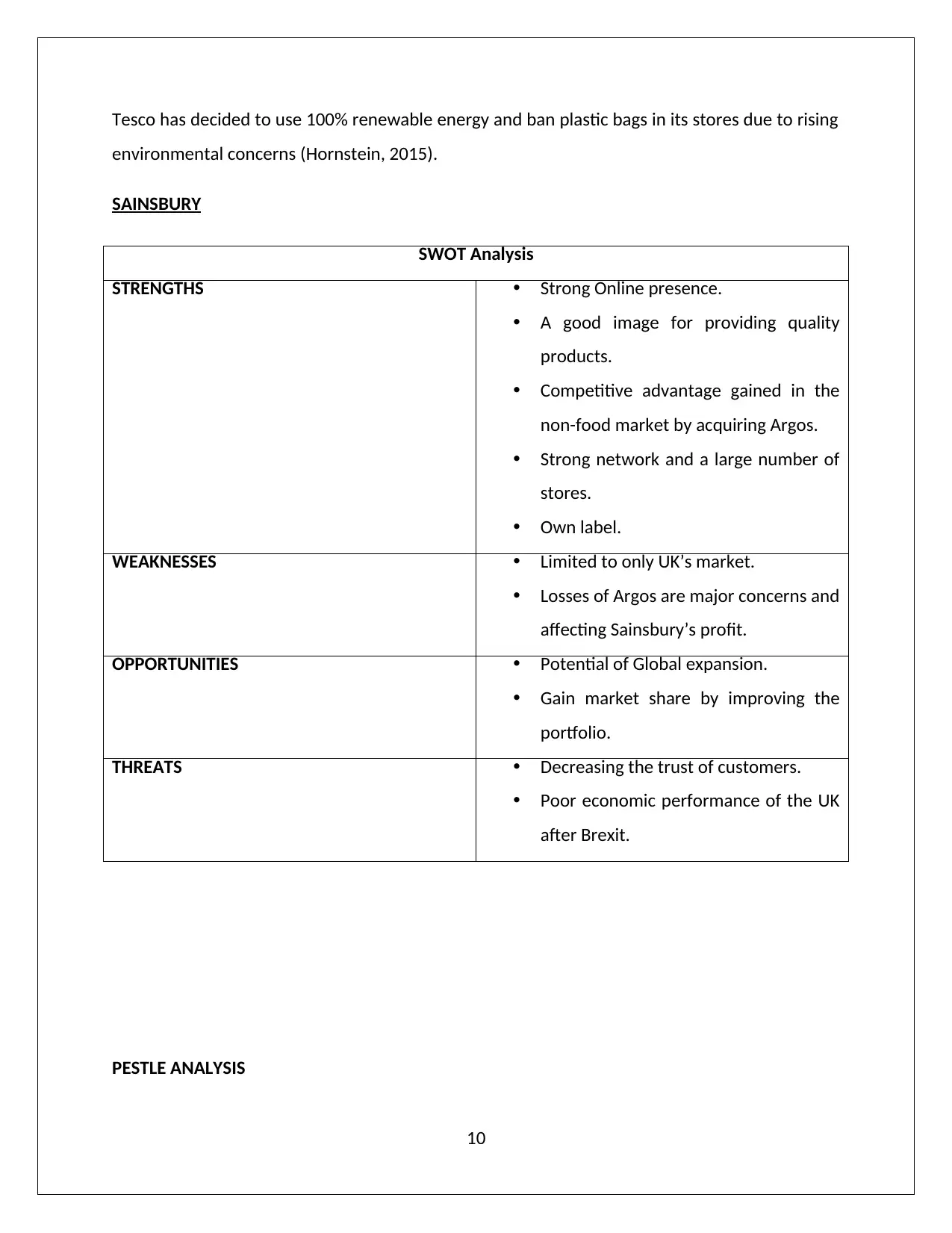
Tesco has decided to use 100% renewable energy and ban plastic bags in its stores due to rising
environmental concerns (Hornstein, 2015).
SAINSBURY
SWOT Analysis
STRENGTHS Strong Online presence.
A good image for providing quality
products.
Competitive advantage gained in the
non-food market by acquiring Argos.
Strong network and a large number of
stores.
Own label.
WEAKNESSES Limited to only UK’s market.
Losses of Argos are major concerns and
affecting Sainsbury’s profit.
OPPORTUNITIES Potential of Global expansion.
Gain market share by improving the
portfolio.
THREATS Decreasing the trust of customers.
Poor economic performance of the UK
after Brexit.
PESTLE ANALYSIS
10
environmental concerns (Hornstein, 2015).
SAINSBURY
SWOT Analysis
STRENGTHS Strong Online presence.
A good image for providing quality
products.
Competitive advantage gained in the
non-food market by acquiring Argos.
Strong network and a large number of
stores.
Own label.
WEAKNESSES Limited to only UK’s market.
Losses of Argos are major concerns and
affecting Sainsbury’s profit.
OPPORTUNITIES Potential of Global expansion.
Gain market share by improving the
portfolio.
THREATS Decreasing the trust of customers.
Poor economic performance of the UK
after Brexit.
PESTLE ANALYSIS
10
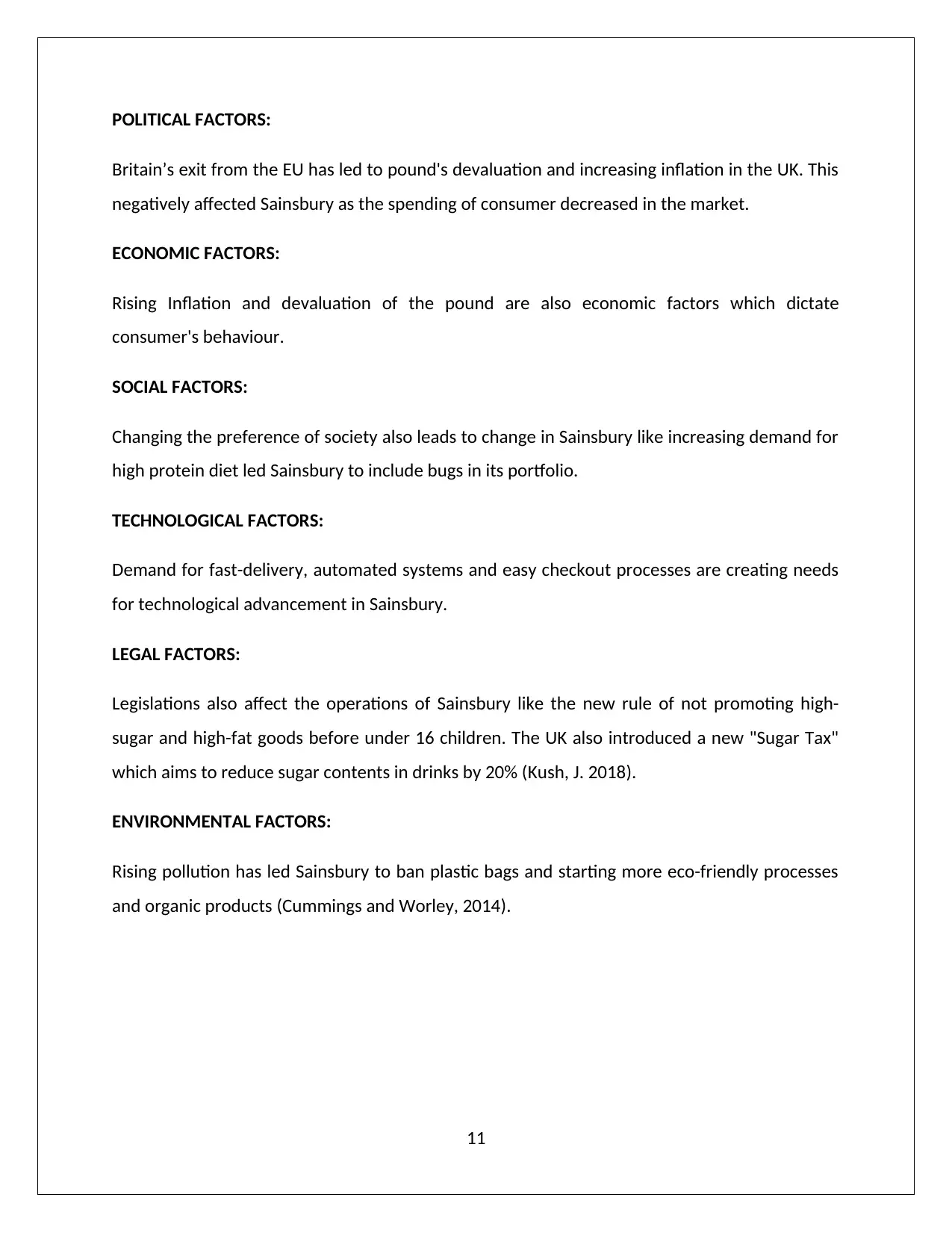
POLITICAL FACTORS:
Britain’s exit from the EU has led to pound's devaluation and increasing inflation in the UK. This
negatively affected Sainsbury as the spending of consumer decreased in the market.
ECONOMIC FACTORS:
Rising Inflation and devaluation of the pound are also economic factors which dictate
consumer's behaviour.
SOCIAL FACTORS:
Changing the preference of society also leads to change in Sainsbury like increasing demand for
high protein diet led Sainsbury to include bugs in its portfolio.
TECHNOLOGICAL FACTORS:
Demand for fast-delivery, automated systems and easy checkout processes are creating needs
for technological advancement in Sainsbury.
LEGAL FACTORS:
Legislations also affect the operations of Sainsbury like the new rule of not promoting high-
sugar and high-fat goods before under 16 children. The UK also introduced a new "Sugar Tax"
which aims to reduce sugar contents in drinks by 20% (Kush, J. 2018).
ENVIRONMENTAL FACTORS:
Rising pollution has led Sainsbury to ban plastic bags and starting more eco-friendly processes
and organic products (Cummings and Worley, 2014).
11
Britain’s exit from the EU has led to pound's devaluation and increasing inflation in the UK. This
negatively affected Sainsbury as the spending of consumer decreased in the market.
ECONOMIC FACTORS:
Rising Inflation and devaluation of the pound are also economic factors which dictate
consumer's behaviour.
SOCIAL FACTORS:
Changing the preference of society also leads to change in Sainsbury like increasing demand for
high protein diet led Sainsbury to include bugs in its portfolio.
TECHNOLOGICAL FACTORS:
Demand for fast-delivery, automated systems and easy checkout processes are creating needs
for technological advancement in Sainsbury.
LEGAL FACTORS:
Legislations also affect the operations of Sainsbury like the new rule of not promoting high-
sugar and high-fat goods before under 16 children. The UK also introduced a new "Sugar Tax"
which aims to reduce sugar contents in drinks by 20% (Kush, J. 2018).
ENVIRONMENTAL FACTORS:
Rising pollution has led Sainsbury to ban plastic bags and starting more eco-friendly processes
and organic products (Cummings and Worley, 2014).
11
⊘ This is a preview!⊘
Do you want full access?
Subscribe today to unlock all pages.

Trusted by 1+ million students worldwide
1 out of 32
Related Documents
Your All-in-One AI-Powered Toolkit for Academic Success.
+13062052269
info@desklib.com
Available 24*7 on WhatsApp / Email
![[object Object]](/_next/static/media/star-bottom.7253800d.svg)
Unlock your academic potential
Copyright © 2020–2025 A2Z Services. All Rights Reserved. Developed and managed by ZUCOL.